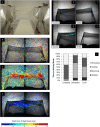Infrared video tracking of Anopheles gambiae at insecticide-treated bed nets reveals rapid decisive impact after brief localised net contact
- PMID: 26323965
- PMCID: PMC4642575
- DOI: 10.1038/srep13392
Infrared video tracking of Anopheles gambiae at insecticide-treated bed nets reveals rapid decisive impact after brief localised net contact
Abstract
Long-lasting insecticidal bed nets (LLINs) protect humans from malaria transmission and are fundamental to malaria control worldwide, but little is known of how mosquitoes interact with nets. Elucidating LLIN mode of action is essential to maintain or improve efficacy, an urgent need as emerging insecticide resistance threatens their future. Tracking multiple free-flying Anopheles gambiae responding to human-occupied bed nets in a novel large-scale system, we characterised key behaviours and events. Four behavioural modes with different levels of net contact were defined: swooping, visiting, bouncing and resting. Approximately 75% of all activity occurred at the bed net roof where multiple brief contacts were focussed above the occupant's torso. Total flight and net contact times were lower at LLINs than untreated nets but the essential character of the response was unaltered. LLINs did not repel mosquitoes but impacted rapidly: LLIN contact of less than 1 minute per mosquito during the first ten minutes reduced subsequent activity; after thirty minutes, activity at LLINs was negligible. Velocity measurements showed that mosquitoes detected nets, including unbaited untreated nets, prior to contact. This is the most complete characterisation of mosquito-LLIN interactions to date, and reveals many aspects of LLIN mode of action, important for developing the next generation of LLINs.
Figures




References
-
- World Health Organisation: World Malaria Report, WHO, Geneva (2014) Available at http://www.who.int/malaria/publications/world_malaria_report_2014/en/ (Accessed 20th Jan 2015)
-
- The Roll Back Malaria Partnership. Global Malaria Action Plan (2008) Available at http://archiverbm.rollbackmalaria.org/gmap/gmap.pdf (Accessed 7th May 2015)
Publication types
MeSH terms
Substances
Grants and funding
LinkOut - more resources
Full Text Sources
Other Literature Sources

